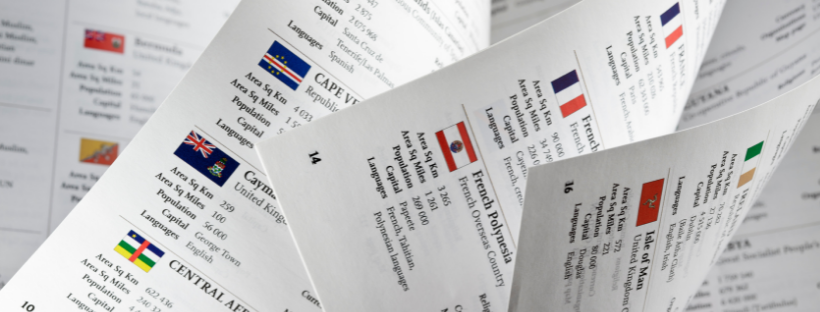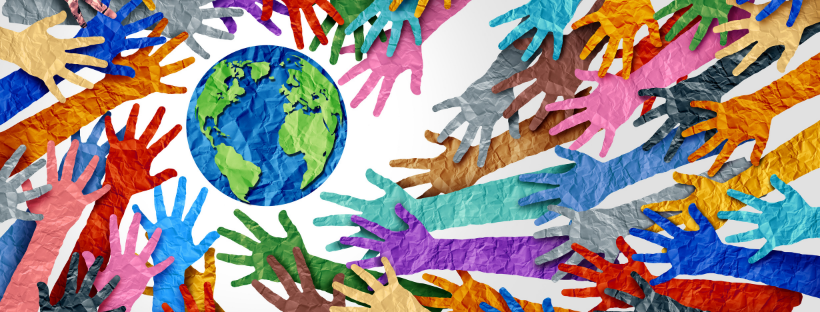Is localization still important in the travel industry? The industry has suffered a lot during the Covid pandemic, which still isn’t over. In this article you’ll learn all that you need to know about localization in the travel industry.

Table of Contents
1. The Importance of Localization in the Travel Industry
2. Travel and Localization
3. What to Translate
4. Human or Machine?
5. Content Triage
6. Workflow Automation Tools
7. Essential Components for a Positive Multilingual Experience
8. Multilingual SEO
9. Social Media Localization
10. Cultural Awareness
11. Top Tips for Travel Companies
12. Key Takeaways
-png.png)
1. The Importance of Localization in the
Travel Industry
The global travel market is huge. More than 1.4 billion people international arrivals occurred annually pre-pandemic. Those living in Asia-Pacific countries and the United States travel outside their continents more often than Europeans. More than 70 percent of Chinese plan trips outside their country annually.
Travel Industry During the Pandemic
While the pandemic temporarily slowed the influx of international arrivals, travel, especially leisure travel, is beginning to come back, according to CNN and Euronet. As quarantines and lockdowns are ending, people are ready for travel. In fact, in a Vrbo survey, most people indicated a desire to travel more than they did pre-pandemic. Many are beginning to book trips. According to Google, more than three-fifths of leisure travelers use the Internet to research, plan, and book their trips. These travelers will be much more likely to book trips when the Websites are in their native language. Videos, travel apps, and the use of concierges will continue to gain importance as we look for ways to accomplish our goals with minimal interaction with strangers. As opposed to face-to-face agents, online travel agents are also becoming key players as people often book at the last minute and seek flexible cancellation policies.
While vaccination rollout may seem slow, millions of people have been fully vaccinated and are becoming eligible to travel. As each day passes, more people become fully vaccinated. The United Nations World Travel Organization is working to harmonize travel protocols across the globe that might allow free travel for those with vaccine passports or negative rapid COVID tests. Countries are beginning to relax their quarantines. This opening up of travel, coupled with the strong desire people have for travel after being quarantined for so long, means that we will soon see waves of travelers.

2. Travel and Localization
Can't Read, Won't Buy
Despite globalization, most people still prefer to buy from sites in their native tongue even if they speak English fluently. A Common Sense Advisory Panel polled consumers in 10 countries to determine the importance of having Websites in their native language vs. having them in English. The survey determined that while about two-thirds of people visit English websites daily, about half the people will spend less time on English websites than those in their own language. The less time they spent, the less likely they were to buy.
Non-native English speakers often visit English websites because they find better prices or a better selection of merchandise. However, they prefer sites translated in their own language even if the translation is poor. Seventy-six percent of them will use machine translation to understand the content better.
Those who are fluent in English were eight times more likely to buy from an English Website. Some countries, such as The Netherlands, have a high percentage of fluent English people. Others, however, such as Thailand, have a low percentage. While the tolerance of fluent non-English speakers for English sites is greater than that of those who are not fluent, they still prefer to buy from sites in their own language, the study showed.
The survey also showed that nine out of 10 Internet users speak no English. Of those individuals, 87 percent of them will not attempt to translate the English site into their language. Citizens in Middle Eastern countries, African countries, and many Asian and Latin American countries often have little English-speaking ability.
The message to travel marketers is clear. Although travelers will search the Internet and may visit English-language Websites, they are much more likely to book travel if the site is translated into their native language. A mediocre translation is better than no translation. Post-edited machine translation (MTPE) is a viable option for a broad range of content, including travel. Translation and localization should be an integral part of your travel marketing strategy.
Languages and Internet Penetration The good news is that while the world's citizens speak more than 7,000 different languages, 80 percent of them can be reached via 12 languages and 90 percent via 13 languages. Companies that can cover 36 languages will likely be able to communicate with and sell to 95 percent of the world's customers.
Travel companies may also find opportunities if they choose to translate content to those in less crowded language markets. Arabic, for example, now outranks German, French, and Russian in terms of size of the market and economic potential. Arabic ranks 11th in overall market
potential, yet most companies opt not to translate their marketing materials into Arabic. Companies that choose to pursue the Arabic-speaking market could find it lucrative.
3. What to Translate
Research shows that translating materials across the entire customer experience often yields the best result. This includes the Website and other online information, manuals, satisfaction surveys, and customer care interactions. The importance of localized content increases over the product life cycle, the survey found.
While some aspects of the Website and applications can be translated effectively using MTPE, other aspects of marketing and advertising require a human linguistic professional's expertise.
Minimum Viable Product (MVP)
If you think you are ready to enter a particular language market, you'll want to test the waters to determine your plans' viability. A process called minimum viable product or MVP may be the way to go. MVP is an agile process, which means it is one that you repeat over and over based upon the feedback you receive each time. Eric Ries popularized MVP in his book The Lean Startup. Yevgeniy (Jim) Brikman developed the concept further in his book, Hello, Startup and the founder of Atomic Squirrel. Brikman described the process as:
- Identifying your riskiest assumption
- Finding the smallest possible experiment to test that assumption
- Using the results of the experiment to course correct You can apply MVP to translation and localization by translating the minimum viable content (MVC) required to do a trial run of a localized Website in a given market. MVC is a natural evolution of MVP and helps you determine whether the market potential warrants a complete localization of your website. It also can help you determine what type of content, such as message and storyline, will work best in that country.
MVC essentially turns content into a product that you test, revise, and then test again. Those companies who have used MVC have found it highly effective in discovering whether localization is worthwhile and the types and lengths of messages that will work best.
4. Human or Machine?
When Machines Are Appropriate
Machine translation has improved dramatically and can translate more efficiently than humans for some types of content. Machine translation is the task of automatically converting text that has been written in one language into text in another language. Often text has some ambiguity
which presents challenges to automatic machine translation. Automatic machine translation has undergone several improvements over its history.
In classical machine translation, linguists developed rules that the machine used for converting the text.
Another traditional type of machine translation, statistical machine translation, uses statistical models to translate. Essentially, SMT translates the content based upon statistical probabilities.
Neural machine translation, or NMT for short, is a new technology. It uses neural network models and is becoming more dominant than SMT because, in many cases, it produces higher quality translations. NMT systems are trained by downloading texts translated by humans in particular industries. Then they build artificial intelligence so that the NMT can develop neural networks. These networks decode language similar to how the human brain decodes rather than relying on rigid rules or statistics. Deep neural machine translation (DNMT), an extension of this, uses multiple neural networks to produce even more highly customized translations. NMT uses only a fraction of the memory of SMT. SMT isn't entirely obsolete, however. Some types of text still can be better translated by SMT.
Two engine types further improve the accuracy of translations. The first is hybrid engines, which use multiple machine translation approaches. These engines seamlessly integrate the strengths of both NMT and SMT. The second is custom engines. Custom engines can further improve the accuracy of translations.
The machines and engines are trained with millions of words of travel data, making machine translation, with human editing, a must for large portions of the content. Those types of travel content that are most suitable for machine translation include:
- Hotel descriptions
- Destination descriptions
- Blogs
- Social media
- Surveys
- Terms and Conditions
- User Reviews
- After-sales support
- Frequently Asked Questions
When Humans Are Most Appropriate
Despite the advances in MT, only a human professional can do the job for some types of content. Humans are more culturally sensitive than machines and can detect the nuances of language better. Examples of content that human linguists must translate are:
- User interface
- Marketing
- Advertising
- Booking agents
- Apps
Training also requires a human intermediary.

5. Content Triage
Localizing your Website and other materials for the international market is a large, complex job, and all of it can't be tackled simultaneously.
Triage is a medical term that refers to assigning degrees of urgency to wounds or illnesses to determine the priority for treatment. The term can be adapted to refer to determining the order for translating content. To prioritize the translation of your content, consider first the audience you want to reach. Also, consider what they'll need the content to do.
In general, you can divide content into four categories, then use the categories to determine priority. Content aimed at customers is translated first. In order of translation priority, the four categories are:
- Customer-directed, higher-value content. This includes content such as advertising materials, annual reports, contracts, and the website's user interface.
- Customer-directed, lower value content. This includes new items, content with a short lifespan, and help desk or knowledge-based content.
- Internally directed, lower value content. This includes emails and other types of day-to-day communication and unofficial blog content.
- Internally directed, high-value content. This includes design specs, employee safety documents, and employee policy manuals.
Once you've determined priorities, you still need to assign content to different types of translation models. For example, you can manage high-volume content with low immediate value, such as thousands of frequently asked questions, with custom MT. When high-quality translations are mandatory, such as for your user interface, you'll want a full-service professional translator. Those materials that aren't appropriate for MT but don't necessarily require the highest quality can be sent to an entry-level human translator. One example is training materials.
Essential Technologies for Dynamic Content-driven Industries
If you try to manage the localization work with your current staff, it will require considerable time and energy away from your core business of providing travel services. One way to manage
your translation process easily is through a translation management system or TMS. A TMS automates and tracks the entire translation process. TMSs help handle the repetitive tasks of moving content in and out of content repositories, such as content management systems (CMS) or marketing automation systems, and channeling it directly to translation teams, engineers, reviewers, and clients. TMSs typically have three components: workflow animation tools, project management tools, and computer-assisted translation.
6. Workflow Automation Tools
Artificial intelligence is one key automation tool. AI can determine what texts work best for human translation or MT, and, if MT, which machine translation engine. When human translation is needed, it compiles a list of the best human linguists for the job and forwards them to the project manager or sends the text directly to an already approved human translator. The AI can recognize several routine aspects of the content that aren't translatable such as phone numbers and Zipcodes, and score them without wasting a translator's time.
Project Management
The TMS automatically tracks progress and manages bottlenecks. Plug-ins can enable it to connect seamlessly to content management systems, marketing automation platforms, and other third-party systems. Examples include Salesforce, Zendesk, Sitecore, Wordpress, and Drupal.
Computer-Aided Translation
These tools also enhance translation quality and include technologies such as document editors, termbase, and translation memory. A termbase is a specific word or phrase that is translated a certain way according to the industry; for example, in the translation industry, CAT is computer-aided translation. At the company Caterpillar, CAT is an abbreviation of the name. Having a termbase enables the machine to translate the phrase accurately for the industry.
Translation memory consists of a database of sentences that are automatically reused when translating the same content again. This saves time and money because it avoids the need for a human translator for these sentences.
A TMS also has other benefits.
- With a TMS, all team members can work directly on the platform
- All moving parts of the project are managed seamlessly without the need for spreadsheets.
- Because translations occur faster and more efficiently, they can save you money on localization.
- They boost productivity and integrate well with other systems.
- Cloud-based TMSs have several additional benefits. These include:
- Lower costs because they avoid the setup and maintenance costs associated with on-premises solutions. They also offer flexible subscriptions that be scaled up or down.
- More secure data without the need for an in-house IT department. They do this through high-standard security protocols.
- Users access at any time from any place with an Internet connection.
- A TMS can help you work your way through your priority list to localize your content efficiently and accurately. The key is finding the right one for your needs. For most companies, one that allows for a fully automated process and blends traditional translation technology with artificial intelligence is a good place to start your search.

7. Essential Components for a Positive
Multilingual Experience
While translation is critical, other localization factors also are essential for customers to have a good user experience in each country. Companies that want their potential customers to have positive, multilingual experiences should strive to offer these components. These are:
- Easy-to-find content that is relevant to the country and language
- Content that you have filtered to be sure it is relevant to your target nation.
- Forms that are tailored to the target nation, including its language, culture, and customs. For example, colors may mean something different in one culture vs. another.
- Legally-compliant transactions. For example, some companies have different tax laws, and you'll want to be sure the customer can adhere to them if they book a trip on your app or Website.
- Customer support at times and in languages convenient for each targeted country.
- Proper design. Some languages require more words to express the same thought; others require fewer. When designing Websites and other collateral, allowing enough space for text expansion based on language is important.
- Brand consistency. The best brands have Websites and other collateral that have a similar appearance no matter where you go in the world. Stick with a global template that can be populated with relevant localized content.
- Proper payment methods. US businesses accept a wide variety of credit cards, but other countries typically accept fewer. Localization takes this into account.

8. Multilingual SEO
Search engine optimization is a critical piece of every online marketing campaign. But SEO in one language doesn't necessarily equal SEO in another. In a multilingual campaign, SEO too must the localized. In the United States, we typically think of optimizing by Google's rules. And more than 90 percent of inquiries globally are initiated on Google. However, some countries do have local engines with market shares larger than Google. In Russia and some Eastern European countries, the search engine Yandex is dominant with a 60 percent share. Search engines Baidu (76 percent share) and Sogou (15.3 percent) dominate in China, while Google is banned. Google also does not dominate in Japan; Baidu, Bing, and Naver do.
Each search engine has different rules. So, if you're implementing a multilingual Web strategy, you'll first need to know which search engines are prominent in the country. You then want to be sure you know the rules of the prominent search engines in each country.
Keywords also do not necessarily translate literally between languages and, even if they do, users may not necessarily search for your brand using the same keywords in each culture. Using a native speaker from the region with experience in the travel industry is a good idea. They can review keywords to help you determine the best ones.
Multilingual SEO also involves other strategies. For example, many search engines dislike duplicate content and could misinterpret your localizations. The use of hreflang tags can tell search engines that your similar Web content is for different audiences. This will prevent your page from being penalized in the rankings for duplicate content.
A good SEO strategy includes external links in the content. However, the proper external links in online content also will vary by country. Sources that customers might consider to be authoritative will differ by region. A native of the country or a translation specialty company can help you determine which sources are most trusted.
Finally, you'll want to consider carefully which domain structure will make Website geotargeting easier for your company. Two options are primary.
Country-code top-level domain
With this scheme, suffixes in the domain associate a Website with a particular geographic area. Some search engines will rank sites with these suffixes higher, but analytics tracking will be trickier as well.
Subdomains
In this scheme, a company buys one generic domain that will host all the company's multilingual versions, then sets up subdomains such as fr.site.com. On some search engines, these sites
benefit from the rankings of the generic domain, but users may have difficulty recognizing the geotargeting at first glance.
9. Social Media Localization
A localized social media presence also is critical in travel e-commerce. Localized social media posts, just like localized Websites, boost sales. When you create localized posts, tweets, or pins, you tell your target audience that you value them and increase your connection with them.
To be successful with social media in different countries, you'll need to develop a specific strategy for each country. You can't assume that the strategy you developed for one country will necessarily work in another. You'll also want, however, to have consistent values across all countries. Just as with search engines, preferred platforms differ by country. Facebook has 2.7 billion users globally but isn't necessarily the top choice in every large market in the world. In Japan, for example, LINE and Mixi are popular. In Russia, Vkontakte is dominant. In China, Instagram, Facebook, and Twitter are banned, and Chinese engage on Weibo. In Norway, the most popular medium is biip.no. To have an effective multilingual social media strategy, you'll need to research the popular medium or mediums for each target market and localize your content for that medium.
The tone of social media interactions also can differ from one country to another. If you've grown up in a country, this tone is instinctive. To be effective in a different culture, you'll need to learn and develop a culturally appropriate tone or outsource your social media localization to a native.
When planning your assets, such as video and infographics, understand that they'll need to be localized. This will save you time in the long run. In developing content, avoid idioms, which seldom translate well, and humor, which also is culturally dependent.
You may also want to create separate localized social media profiles for each country that appeal to that culture. This will keep the engagement level high. Here are few other items to keep in mind when developing localized profiles:
- The seasons differ; it might be summer in one locale while it's winter in another. A photo of folks lounging by a pool might work really well in those countries where the season is summer but would be totally irrelevant during winter.
- Holidays also differ. Sending a Happy Father's Day message in June may be welcomed in the United States, but seem very strange in another country that celebrates the holiday on a different day or not at all.
- Social media posts also often key around sports events or news events, all of which will differ by country.
- Cultural mores differ, so photos should fit into those mores. Particularly important to note is whether people of different genders can appear in the same photo and how women can be photographed in different cultures.
Of course, social media links should always refer back to a localized Website.
10. Cultural Awareness
Translating your Website and other materials into the target country's language is important, but it is only a start. The world has become ultra-sensitive to cultural slurs. Cultural awareness and sensitivity are not only politically correct; they are economically critical. A major blunder can cause a brand's sales to drop, or in some cases, to have the brand's advertising banned in the company altogether.
Cultural sensitivity is the awareness of specific cultural factors such as religious beliefs, attitudes, values, aesthetics, and social organization. It requires marketing teams to be aware of nuances to avoid mistakes and to develop appropriate messaging. One common mistake Western brands make when reaching out to China's market, for example, is to use nostalgic imagery of rice fields and bicycles. Modern Chinese, instead, want to see images of a hip society to which their young adults aspire.
Another example is a blunder by the automated BMW. BMW made the mistake of misusing the flag of the United Arab Emirates, which includes Scripture from the Qur'an, on beer bottles, causing great offense. Another example: When Pampers launched its product in Japan, they used an image of a stork carrying a diaper in its mouth. But, in Japan, the myth is that a floating peach delivers babies.
Cultural sensitivity also includes talking with your customers in the way they expect to be spoken to. For example, countries have different approaches to the use of color; in some cultures, white means death, while in others, it signifies purity. Countries also present time, measurements, and dates in different ways. So, even if you are dealing with two countries that speak the same language, you'll want to localize the measurements and times to meet each country's conventions.
Another example is the presentation of women. In many countries, the image of a woman clad in a bikini in a hotel spa would be inviting; however, it would be offensive in Muslim countries. In some countries, religion and culture are very intertwined. For example, a restaurant would want to avoid presenting images of eating bacon during Ramadan in Muslim countries or in any country where Muslims have a large presence.
11. Top Tips for Travel Companies
Translating and localizing travel content for target markets can be challenging. Here are a few tips for making sure you master the task.
- Use a professional translation provider and choose them carefully. Ask about their services and tools and ensure they can accommodate localization and not just translation.
- Always have some human touch to your translations -- whether your own staff or those of your provider. Involving humans who are natives of your target countries is a bonus.
- Set realistic deadlines for translation projects and plan well to meet them.
- Keep the number of translators for each project to a minimum to ensure consistency.
- Remember, some languages take up more space than others. Plan accordingly in your designs. Choose font and style carefully.
- One word can often be translated in multiple ways. TMSs can use translation memory and termbase to translate terms consistently.
- Multilingual style guides and glossaries are important.
- Give your translator as much context as possible and answer questions promptly.
- Translation is a profession, and the best human translators are elite professionals.
- Keep culture in mind in translation. Be mindful of nuances of language, color, and idiomatic expressions. Above all, do no harm. Learn what might offend those of another culture, using a native from the region if possible, to avoid embarrassing and costly blunders.
- Use the same translation provider to save money and be consistent.
- Use translation technology such as TMS and MT as appropriate to improve productivity and efficiency.
- Consider creating different social media profiles or personas that are relevant for each target market.
- Companies that are successful across many continents effectively balance the need for a consistent brand message and values with the need to adapt the specifics of how they communicate that message and values to the local culture
- Remember that localization is more than translation. A firm that already understands the cultural nuances can often save you money in the long run.

12. Key Takeaways
- The travel market is recovering. People are itching to get away after a year in quarantine. Uniform protocols are being developed to enable leisure international travel.
- If people have trouble reading and understanding your Website, they won't book their travel. In fact, even if they speak the foreign language fluently, they still prefer the information in their own language.
- Potential customers are using machine translations to understand the content on travel Websites. Even a mediocre translation is better than nothing.
- Most of the world can be reached via 12 or 13 languages. Opportunities exist in countries that have previously been unserved.
- While ultimately all content should be translated, you can prioritize the order by groups of content. Customer-related content is always translated first.
- The technology involved in machine translations has improved greatly through the use of artificial intelligence.
- The human touch is still required for some translations.
- Having a translation management system saves you money. The translation management system organizes and tracks the entire translation process and can automatically route translations to humans or to machines. It also can determine the right translation engine for machine translations and integrate with other programs you have.
- The translation isn't the whole picture. You also need to be sure your Website follows the legal rules in each country, accepts payments likely to be used in the country, and is easy to use in any culture.
- While SEO is critical to digital marketing in all countries, the mechanics differ in each country. Don't assume that search engines and keywords will be the same across cultures.
- While people in most countries engage on social media, the medium of choice differs, and how people engage differs.
- Being sensitive to cultural nuances is critical for success.
- Companies seeking to create multilingual sites should follow certain tips developed by experts and consider seeking help from experts to improve accuracy and efficiency.
- The travel industry is experiencing a post-COVID bounce. People from all over the world are traveling again. Companies that show they care about their international customers can gain this travel business. Accurate localization of the Website, social media, and apps is critical to demonstrating that you understand and care about multilingual customers.
- Andover can help you localize your content efficiently and accurately. We have six offices located strategically in the world to provide customer service at any time. We provide
- Scalability through more than 5,000 translators and cutting-edge technology. We have native translators from just about every country.
- Technical Expertise to handle everything from Websites to apps, to videos, to cloud software in both mature and emerging markets.
- Automation, including an excellent TMS known as Memsource.
- Customized solutions that seamlessly integrate our TMS with our managed services to meet your needs.

For more tips and content for global growth, please visit our blog.











